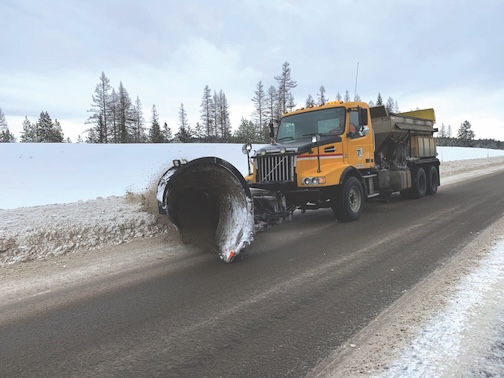Study finds old growth trees in Blue Mountains dying at high rate
Published 7:38 am Tuesday, July 15, 2025
James Johnston has been studying trees in the Blue Mountains that are older than America, and he’s disturbed by how many trees, after surviving for a few centuries or longer, died during a single decade.
“It’s really alarming that trees capable of living to be a thousand years old” are dying, in substantial numbers, Johnston said, at far less than half that age.
He is an assistant research professor in the University of Oregon’s Institute for Resilient Organizations, Communities, and Environments. He called the future of old growth forests “pretty bleak” in the parts of the Malheur National Forest that he and his colleagues studied in detail.
Trending
And Johnston worries the mixture of maladies killing some of the oldest trees on the Malheur are doing the same elsewhere in the Blues, including the Wallowa-Whitman and Umatilla national forests, where the situation is “very similar.”
Johnston, a fire ecologist, led a team of researchers who published their findings July 8 in the journal “Forest Ecology and Management.”
They mapped about 1,620 trees in 2012-13 at 11 sites around the Malheur, taking core samples to determine the trees’ ages, which ranged from 17 to 661 years with an average age of 122 years. The study trees were all in areas where little or no logging has happened.
The study examines six species — ponderosa pine, western larch, Douglas-fir, lodgepole pine, grand fir and western juniper.
The researchers returned a decade later, in 2022 and 2023, to see how many of the trees they cataloged had died.
The answer, Johnston said, was considerably more trees than he expected.
Trending
Overall, 28% of the trees had died in the span of a decade.
The toll was higher — about 33% — for trees between 150 and 300 years old.
And about 25% — 1 in 4 — trees older than 300 years old had died.
“It’s sad to see so many old trees dying,” Johnston said.
His team’s study notes “our simulations and comparisons with previous research suggests that the mortality we observed is well in excess of normal.”
Johnston and the other researchers concluded several factors contributed to the trees’ demise, including a warming and drying climate, insect infestations and wildfire, but the chief threat is overcrowding.
“There’s too many trees on the landscape,” he said.
The more trees, the greater the competition for water and soil nutrients. The crowded conditions can stifle tree growth and make trees more susceptible to potentially lethal agents including insects, disease, drought and fire, Johnston said.
The researchers found that trees that had relatively slow growth rates, as calculated through the core samples taken in 2012-13, were more likely to have died during the ensuing decade.
Why so many trees?
Johnston said two factors played crucial roles in creating the current overcrowded forests he studied on the Malheur National Forest.
One is fire suppression.
Starting early in the 20th century, spurred by a catastrophic blaze in 1910 in Montana and Idaho, the U.S. Forest Service strived to douse fires as quickly as possible.
The campaign was epitomized by the “10 o’clock rule” — the agency’s goal to extinguish every blaze by 10 a.m. the day after it was reported.
The effort, which was adopted by other federal, state and local agencies, was generally successful.
Too successful, Johnston said.
Lightning-sparked fires that for millennia had swept through large swathes of the Blue Mountains — Native Americans also ignited blazes seasonally — killed seedling trees and maintained the forests that entranced white settlers when they began arriving in the 19th century.
Those forests had relatively few trees, and the frequent fires prevented logs, cones, needles and other combustible debris from accumulating.
But as the decades passed, those young trees, which didn’t survive the periodic fires, continued to grow. Many of these are grand firs, a species that can thrive in the shade of old growth trees.
While those trees were proliferating, the Forest Service was putting out timber sales that focused on the old growth trees, in particular ponderosa pines and western larches (also known as tamaracks), Johnston said.
“We cut down a lot of old growth ponderosa pine in the Blue Mountains between 1920 and 1990,” Johnston said.
A shift in federal forest policy starting in the early 1990s largely curtailed old growth logging.
Yet Johnston believes the new study, along with past research, shows this strategy, designed to protect the relatively small percentage of remaining old growth trees, is contributing to their demise.
“Old growth in the Blue Mountains can’t seem to catch a break,” he said.
Since logging of old growth largely ended more than three decades ago, Johnston said, “we’ve failed to manage the remaining old growth in a way that they can persist. We’ve struggled to make the right decisions.”
He believes the key to saving those ancient trees is the same tool that felled them in their thousands for much of the 20th century: the chain saw.
Johnston calls for cutting many of the trees that have taken advantage of the absence of fire over the past century.
Some of those trees are big enough that they could be sold to mills, generating revenue for the Forest Service and helping to pay for other forest restoration work.
“The weight of available evidence suggests that mechanical treatments (such as logging) that reduce forest density by removing young trees are an effective strategy for conserving old trees,” according to the researchers’ findings in “Forest Ecology and Management.”
That technique faces obstacles, however, in the places that Johnston and his team studied.
One of the 11 sites is inside the Strawberry Mountain Wilderness south of Prairie City. Federal law prohibits logging in wilderness areas.
The 10 other sites, although outside wilderness, are in inventoried roadless areas. A 2001 Forest Service policy, known as the Roadless Rule, largely ended logging in roadless areas.
On June 23, U.S. Department of Agriculture Secretary Brooke Rollins announced that the Trump administration intends to rescind the Roadless Rule.
Prescribed fire also can be a valuable tool in maintaining a healthy forest — “we don’t do nearly enough of it,” Johnston said.
But he believes fire alone can’t help ailing old growth forests. Prescribed blazes can kill very young trees, but the tactic won’t work in forests like those that his team studied, where the trees crowding out the old growth are themselves many decades old.
How competition threatens old growth trees
The proliferation of younger trees in old growth forests doesn’t directly kill the older trees, Johnston said. But the competition for the finite supplies of water and nutrients can weaken all the trees, leaving them vulnerable and slowing their growth — the latter measure directly correlating with tree death rates in his team’s research.
A significant factor on the Malheur National Forest was a rare epidemic of pine butterflies from 2010-12, with the highest populations south of the John Day River.
Although the butterflies are “defoliators,” meaning they can kill tree needles, Johnston said the insects generally don’t kill trees outright.
But defoliated trees are more susceptible to other bugs, particularly western pine beetles and mountain pine beetles, that often kill trees. Johnston and his team concluded that those two beetles killed many of the ponderosa pines they examined in 2022 and 2023.
Drought also likely weakened trees during the decade of the study, Johnston said.
Wildfires also played a role.
Parts of four of the 11 study sites burned between 2012-13 and 2022-23. Almost half of the trees studied in those sites — 225 of 448 — died over the decade, and researchers concluded that fire killed 168 of those trees.
The future
Johnston and his team studied the potential for younger trees to eventually replace the old growth trees that died.
The results are not promising, he said.
Even if old growth trees stop dying — a trend Johnston doesn’t expect — it would still take the better part of a century to replace the 150- to 300-year-old trees that died during the period of the study.
And that hypothetical forest would be different from historic stands, with a higher proportion of grand fir — the species that benefited from the exclusion of fire — compared with the historically predominant ponderosa pine and tamarack, Johnston said.
The problem with that scenario, he said, is that grand fir tends to be more vulnerable to drought, insects and other threats than other trees.
Johnston hopes his team’s findings will spur similar studies elsewhere in the Blue Mountains, as well as experiments to test his belief that cutting younger trees will help spare old growth trees from drought, insects, disease and fire.
“We really need large data sets over larger areas,” he said.










